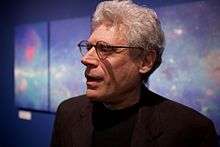David Em
| David Em | |
|---|---|
 David Em, Transjovian Pipeline, 1979, Digital Image | |
| Born |
1952 Los Angeles, California, USA |
| Nationality | American |
| Education |
Pennsylvania Academy of the Fine Arts American Film Institute |
| Known for | Digital art |
David Em (born 1952) is an American computer artist.
Life and work
David Em was born in Los Angeles and grew up in South America. He studied painting at the Pennsylvania Academy of the Fine Arts and film directing at the American Film Institute.
Em created digital paintings at the Xerox Palo Alto Research Center (Xerox PARC) in 1975 with SuperPaint, "the first complete digital paint system".[1] In 1976, he made an articulated 3D digital insect at Information International, Inc. (III) that could walk, jump, and fly, the first 3D character created by a fine artist.[2]

With his 1977 art work Aku, Em became the first artist to produce a navigable virtual world at NASA’s Jet Propulsion Laboratory (JPL), where he was Artist in Residence from 1977 to 1984.[3] He also created digital art at the California Institute of Technology (1985 – 1988), and Apple Computer (1991).[4] Em has worked independently since the early nineties.
Scope of work
|
|
Em's art spans multiple media, including virtual worlds, filmmaking, printmaking, and photography. He has also worked with live performance and theater.[5] Most of his creations exist outside of the mainstream art world.
Stylistically, Em's art has connections to Surrealism, abstract painting, and experimental film. Some pieces feature geometric components, others are organic in nature.
He says he "makes pictures with electronic light” and "sculpts with memory instead of space.”[6] He also "evolves images so that they grow into and out of each other”.[7]
Some of his early art created at the Jet Propulsion Laboratory in the 1970s has deep-space related themes. In the 1980s he incorporated light effects reminiscent of the French Impressionists,[8] and in the 1990s he introduced otherworldly lifeforms into his work. In the first decade of the Twenty-First century, an apocalyptic element appears in his imagery. His current work relates to consciousness and the neurosciences.
His art has been exhibited at the Centre Pompidou, the Musee d’Art Moderne de la Ville de Paris, the Seibu Museum in Tokyo, the Carpenter Center for the Visual Arts, and the Museum of Contemporary Art, Los Angeles. He has given talks at Harvard, MIT, The University of Paris, The Academy of Motion Picture Arts and Sciences, and the American Association for the Advancement of Science. His work has appeared in popular media, including the covers of Herbie Hancock's Future Shock, Sound-System, and Perfect Machine albums and an electronic version of William Gibson’s Neuromancer. He is the first digital artist to have his working papers acquired by the Smithsonian Institution’s Archives of American Art.
Em has curated several exhibitions, including "The Shape of the Universe," November 30, 2011, at Pasadena City College with assistance from NASA and Caltech. The exhibit featured recent deep space photographs and computer simulations.[9]

Notes
- ↑ Perry, T. & Wallich, P.:"Inside the PARC: The Information Architects", Pages 68-69, "IEEE Spectrum", October 1985
- ↑ Sorensen, P. "Computer Pictures", "David Em Modern Master" May 1988
- ↑ Nelson, Ted "Creative Computing", "Report on Siggraph '81", March 1982
- ↑ Haggerty, M. "IEEE Computer Graphics and Applications" page 4 "Computer Painting in a Different Light." Nov. 1992
- ↑ Michie, Donald and Rory Johnston. “The Creative Computer”, Viking, 1984, pp. 139-140
- ↑ Deken, Joseph “Computer Images: State of the Art,” , Stewart, Tabori, and Chang, 1983, page 133
- ↑ Wands, Bruce. “Art of the Digital Age”, Thames and Hudson, 2006, page 48
- ↑ Trachtman, P. "Smithsonian Magazine" "Impressionist with a Computer" 1988.
- ↑ http://www.cosmotography.com/images/pasadena_art_gallery/ShapeOfTheUniverse.html
Further reading
- Bradbury, Ray (1984). "Em Squared". David Em at OCCA (exhibition catalogue). Orange County Center for Contemporary Art.
- Gardiner, Jeremy; Malone, Seamus; Lambert, Nick (February 24, 2009). "Interview with David Em". Computer Art & Technoculture. Los Angeles. Retrieved 2015-05-06.
- Kleiner, Fred S.; Mamiya, Christin J. (2004). Gardner's Art Through the Ages (12th ed.). Harcourt Brace Jovanovich.
- Ross, David (1988). The Art of David Em. New York: Harry N. Abrams.
- Zelanski, Paul; Fisher, Mary Pat (2007). The Art of Seeing (7th ed.). Upper Saddle River, NJ: Pearson Prentice Hall.
